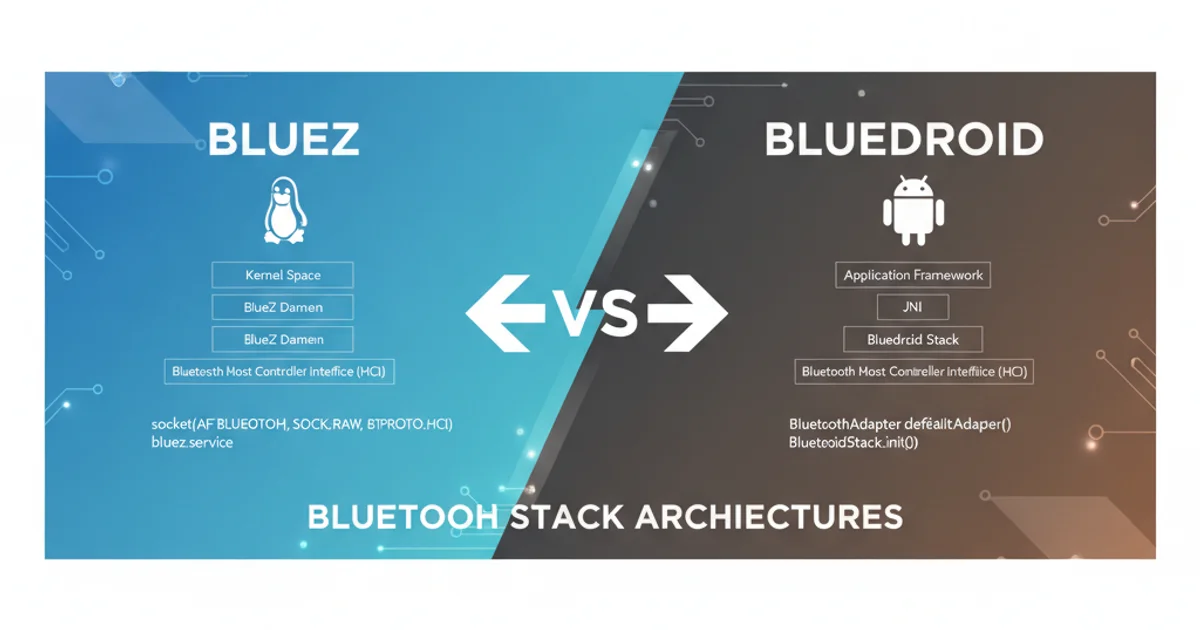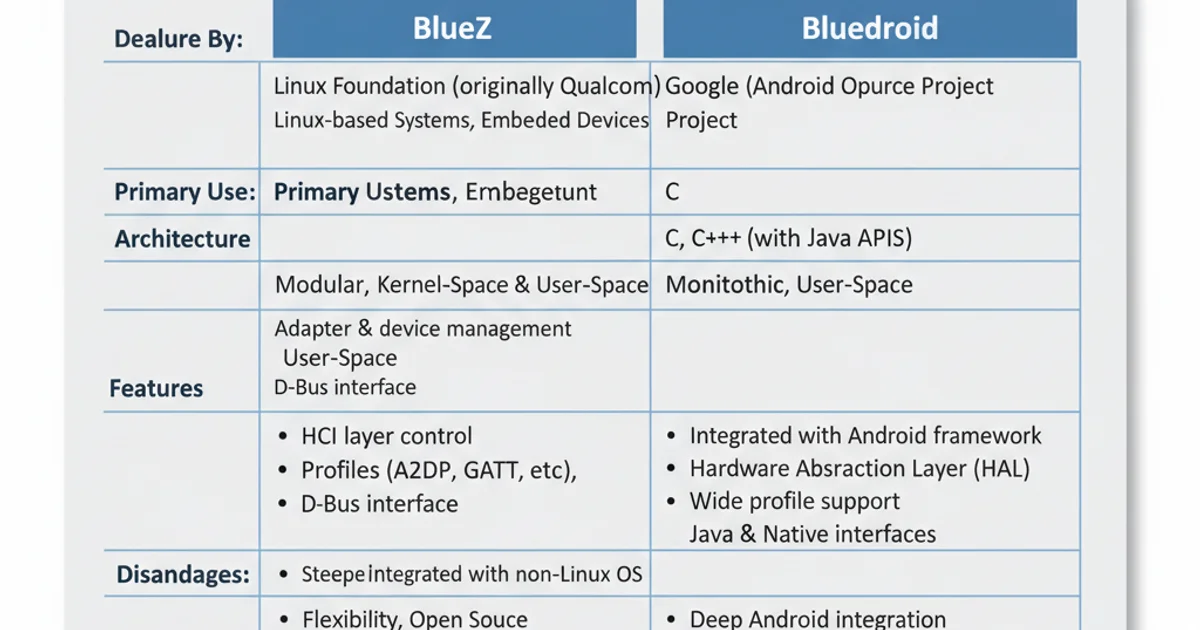BlueZ vs Bluedroid bluetooth stack
Categories:
BlueZ vs. Bluedroid: Understanding Bluetooth Stacks in Android

Explore the fundamental differences between BlueZ and Bluedroid, the two primary Bluetooth stacks, and their roles in Android's Bluetooth ecosystem, including A2DP support.
Bluetooth technology is ubiquitous, connecting countless devices from headphones to smartwatches. At the heart of this connectivity are Bluetooth stacks, software implementations that handle the complex protocols required for communication. In the Android ecosystem, two names frequently come up: BlueZ and Bluedroid. While both serve the same fundamental purpose, their origins, architectures, and roles within Android differ significantly. This article delves into these differences, helping you understand which stack is used where and why, with a particular focus on audio profiles like A2DP.
BlueZ: The Linux Bluetooth Standard
BlueZ is the official Linux Bluetooth protocol stack. It's an open-source project that has been the standard Bluetooth implementation for Linux-based systems for many years. Its architecture is modular, allowing different components to be enabled or disabled based on system requirements. BlueZ provides a robust and feature-rich set of functionalities, including support for various Bluetooth profiles (like A2DP, HFP, HID, etc.) and low-energy features. Historically, early versions of Android (up to Android 4.1 Jelly Bean) utilized BlueZ as their primary Bluetooth stack. However, due to licensing concerns and the need for more Android-specific optimizations, Google eventually transitioned to its own stack.
flowchart TD
A[Bluetooth Hardware] --> B[HCI (Host Controller Interface)]
B --> C[BlueZ Kernel Modules]
C --> D[BlueZ Daemon (bluetoothd)]
D --> E[D-Bus Interface]
E --> F[User-space Applications (e.g., pulseaudio, gnome-bluetooth)]
D -- A2DP, HFP --> G[Audio Subsystem]
subgraph BlueZ Stack
C
D
E
endSimplified architecture of the BlueZ Bluetooth stack
Bluedroid: Android's Native Bluetooth Stack
Bluedroid is Google's proprietary Bluetooth stack, developed specifically for the Android operating system. It was introduced in Android 4.2 Jelly Bean and has been the default stack ever since. Bluedroid was designed to address some of the limitations and integration challenges faced with BlueZ in the Android environment. It's written primarily in C and C++ and is deeply integrated with the Android framework, offering better performance, power management, and tighter control over Bluetooth operations within the mobile context. Bluedroid supports a wide array of Bluetooth profiles, including A2DP for high-quality audio streaming, which is crucial for modern Android devices.
flowchart TD
A[Bluetooth Hardware] --> B[HCI (Host Controller Interface)]
B --> C[Bluetooth HAL (Hardware Abstraction Layer)]
C --> D[Bluedroid Stack (BluetoothService)]
D --> E[JNI (Java Native Interface)]
E --> F[Android Framework (Java APIs)]
F --> G[Android Applications]
D -- A2DP, HFP --> H[AudioFlinger/Audio Policy Manager]
subgraph Bluedroid Stack
C
D
E
endSimplified architecture of the Bluedroid Bluetooth stack in Android
Key Differences and A2DP Support
The primary distinction between BlueZ and Bluedroid lies in their target environments and architectural philosophies. BlueZ is a general-purpose Linux stack, while Bluedroid is optimized for Android's mobile, resource-constrained, and application-driven environment. Both stacks provide robust support for the Advanced Audio Distribution Profile (A2DP), which is essential for streaming high-quality stereo audio to Bluetooth headphones and speakers. The implementation details, however, differ. Bluedroid's A2DP implementation is tightly coupled with Android's audio framework (AudioFlinger), ensuring seamless integration with media playback and routing. BlueZ, on the other hand, typically integrates with Linux audio servers like PulseAudio or PipeWire to handle A2DP audio streams.

Feature comparison between BlueZ and Bluedroid
Understanding these differences is crucial for developers working on Bluetooth-enabled applications or custom Android ROMs. For most Android users and app developers, Bluedroid is the relevant stack, and interactions are primarily through the Android Bluetooth APIs. For those working with embedded Linux or custom hardware, BlueZ might still be a consideration.
import android.bluetooth.BluetoothAdapter;
import android.bluetooth.BluetoothDevice;
import android.bluetooth.BluetoothProfile;
import android.bluetooth.BluetoothA2dp;
public class A2dpExample {
private BluetoothAdapter bluetoothAdapter;
private BluetoothA2dp bluetoothA2dp;
public A2dpExample() {
bluetoothAdapter = BluetoothAdapter.getDefaultAdapter();
if (bluetoothAdapter == null) {
// Device doesn't support Bluetooth
return;
}
bluetoothAdapter.getProfileProxy(null, new BluetoothProfile.ServiceListener() {
@Override
public void onServiceConnected(int profile, BluetoothProfile proxy) {
if (profile == BluetoothProfile.A2DP) {
bluetoothA2dp = (BluetoothA2dp) proxy;
// Now you can use bluetoothA2dp to connect/disconnect A2DP devices
// For example, to get connected A2DP devices:
// List<BluetoothDevice> connectedDevices = bluetoothA2dp.getConnectedDevices();
}
}
@Override
public void onServiceDisconnected(int profile) {
if (profile == BluetoothProfile.A2DP) {
bluetoothA2dp = null;
}
}
}, BluetoothProfile.A2DP);
}
// ... further methods to interact with A2DP profile
}
Example of obtaining the A2DP profile proxy in Android using Bluedroid's underlying services.